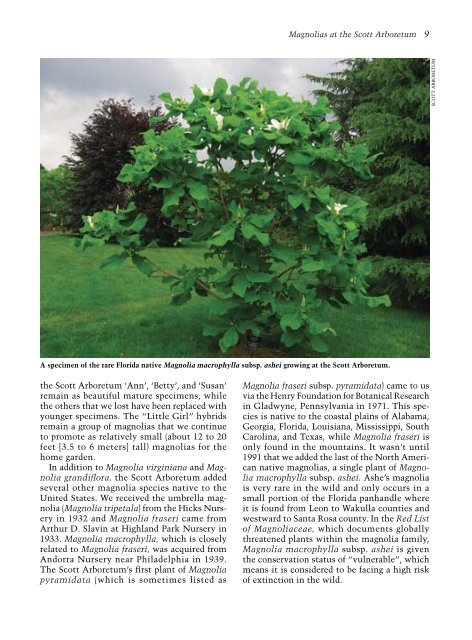The Magazine of the Arnold Arboretum - Arnoldia - Harvard University
The Magazine of the Arnold Arboretum - Arnoldia - Harvard University
The Magazine of the Arnold Arboretum - Arnoldia - Harvard University
Create successful ePaper yourself
Turn your PDF publications into a flip-book with our unique Google optimized e-Paper software.
Magnolias at <strong>the</strong> Scott <strong>Arboretum</strong> 9<br />
Scott <strong>Arboretum</strong><br />
A specimen <strong>of</strong> <strong>the</strong> rare Florida native Magnolia macrophylla subsp. ashei growing at <strong>the</strong> Scott <strong>Arboretum</strong>.<br />
<strong>the</strong> Scott <strong>Arboretum</strong> ‘Ann’, ‘Betty’, and ‘Susan’<br />
remain as beautiful mature specimens, while<br />
<strong>the</strong> o<strong>the</strong>rs that we lost have been replaced with<br />
younger specimens. <strong>The</strong> “Little Girl” hybrids<br />
remain a group <strong>of</strong> magnolias that we continue<br />
to promote as relatively small (about 12 to 20<br />
feet [3.5 to 6 meters] tall) magnolias for <strong>the</strong><br />
home garden.<br />
In addition to Magnolia virginiana and Magnolia<br />
grandiflora, <strong>the</strong> Scott <strong>Arboretum</strong> added<br />
several o<strong>the</strong>r magnolia species native to <strong>the</strong><br />
United States. We received <strong>the</strong> umbrella magnolia<br />
(Magnolia tripetala) from <strong>the</strong> Hicks Nursery<br />
in 1932 and Magnolia fraseri came from<br />
Arthur D. Slavin at Highland Park Nursery in<br />
1933. Magnolia macrophylla, which is closely<br />
related to Magnolia fraseri, was acquired from<br />
Andorra Nursery near Philadelphia in 1939.<br />
<strong>The</strong> Scott <strong>Arboretum</strong>’s first plant <strong>of</strong> Magnolia<br />
pyramidata (which is sometimes listed as<br />
Magnolia fraseri subsp. pyramidata) came to us<br />
via <strong>the</strong> Henry Foundation for Botanical Research<br />
in Gladwyne, Pennsylvania in 1971. This species<br />
is native to <strong>the</strong> coastal plains <strong>of</strong> Alabama,<br />
Georgia, Florida, Louisiana, Mississippi, South<br />
Carolina, and Texas, while Magnolia fraseri is<br />
only found in <strong>the</strong> mountains. It wasn’t until<br />
1991 that we added <strong>the</strong> last <strong>of</strong> <strong>the</strong> North American<br />
native magnolias, a single plant <strong>of</strong> Magnolia<br />
macrophylla subsp. ashei. Ashe’s magnolia<br />
is very rare in <strong>the</strong> wild and only occurs in a<br />
small portion <strong>of</strong> <strong>the</strong> Florida panhandle where<br />
it is found from Leon to Wakulla counties and<br />
westward to Santa Rosa county. In <strong>the</strong> Red List<br />
<strong>of</strong> Magnoliaceae, which documents globally<br />
threatened plants within <strong>the</strong> magnolia family,<br />
Magnolia macrophylla subsp. ashei is given<br />
<strong>the</strong> conservation status <strong>of</strong> “vulnerable”, which<br />
means it is considered to be facing a high risk<br />
<strong>of</strong> extinction in <strong>the</strong> wild.

















